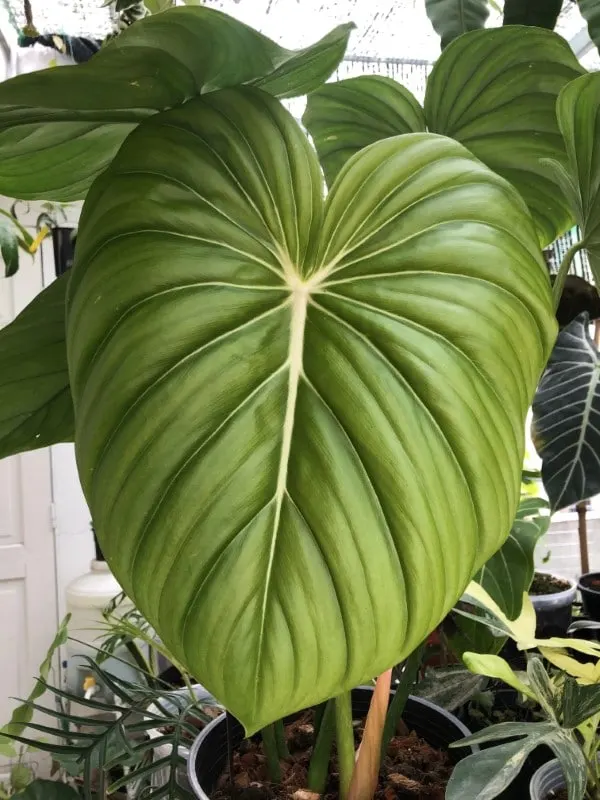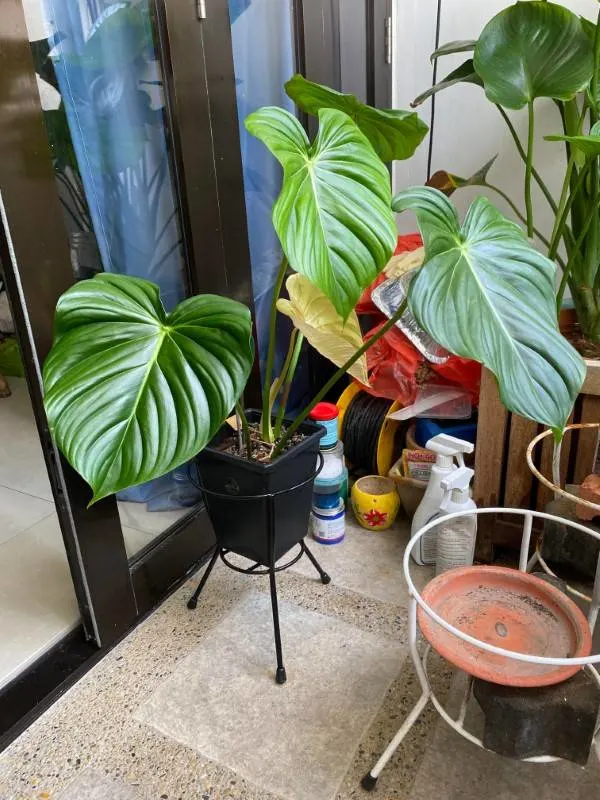Philodendron Mcdowell comes with large and heart-shaped leaves with prominent white veins set against the dark green color. The important thing about this plant is that it is easy to grow indoors or outdoors.
Its keeping requirements are different from other varieties, making it easy to grow. When buying large Philodendron Mcdowell, keep in mind that they will need room for the roots.
With a lack of space, feathery leaves are often injured or torn. When placed close to a window pane, if the plant is standing in a hallway or staircase, it may leave scars, frost-glass stains, or sunburn.

Philodendron Mcdowell care tips
1. Temperature regime
In the spring-summer period, the best air temperature for Philodendron Mcdowell will be from 20 to 24 degrees. However, if you moisten its foliage often enough with a spray bottle, then you can grow it at higher temperatures.
It needs coolness (about 15 degrees) during winter, and remember that the bush should be located as far as possible from heating appliances.
If you cannot transfer Philodendron Mcdowell to an excellent place for the winter, let it grow where it grew while moisturizing the foliage and watering it in the same way as in the warm season. During warm wintering, its growth and development will not stop but will slow down significantly.
2. The choice of a flowerpot, soil, and drainage
The soil should be loose, moisture-permeable well. Otherwise, stagnant water in the soil can cause root rot. The substrate should be slightly acidic. A mixture of peat, rotted leaves, turf, and sand is suitable for a Philodendron Mcdowell.
To ensure quick drainage of excess moisture, good drainage must be provided. It can be expanded clay, broken brick, and crushed foam.
It is better to take a ceramic or clay pot for a Philodendron Mcdowell. This allows air to pass through nicely and the roots to breathe. The roots of the plant grow mainly in breadth. Therefore, a wide and shallow container is suitable for it.
3. Lighting
Bright place, protected from sunlight at noon and light partial shade, is suitable for Philodendron Mcdowell. Also, a little more light is good, preferably morning or evening sun.
Likewise, this plant is unpretentious and can grow in whole artificial light and near the northern window. But powerful and spreading bushes form only in good lighting.
Philodendron Mcdowell grows from May to October on the southern windowsill, and the only shading is a light mosquito net.
4. Watering
The soil for Philodendron Mcdowell should be moist all the time, which means that by the next watering, the earth in the upper third of the pot should dry out sufficiently.
In winter, watering is reduced only complete drying of the soil is not allowed, the earth should dry out, in the upper half of the pot, then you need to wait another 3-4 days before watering.
With excess watering, the lower leaves may turn yellow, if the soil dries out for too long, it will be too dense and will not allow the roots to breathe, and root rot may develop.
Do not forget that the roots of Philodendron Mcdowell must breathe, which does not happen in dense swampy soil. With a lack of moisture, the tips of the leaves dry out with strong dryness. As a rule, the lower leaves dry out and fall off.
5. Fertilizer
From March to October, Philodendron Mcdowell is fed with a complex fertilizer. Top dressing every two weeks. For large tree-like vines, you can add well-rotted compost to the top layer of the earth once a summer with or without the transplant.
When feeding this plant with fertilizers, it’s crucial not to overfeed; otherwise, the leaves’ tips turn brown or yellow, the leaves will wither and then become lifeless.
If you add a significant proportion of humus to the soil, do not feed it with other fertilizers for at least 2 months.
On the contrary, Philodendron Mcdowell often suffers from a lack of nutrients in the soil if it is not transplanted for a long time and forgets to feed. At the same time, the leaves become smaller, their tips dry and turn yellow, and the plant lags in growth.
6. Air humidity
The humidity in the room where the Philodendron Mcdowell is located should be increased. To achieve this, it is necessary to moisten the foliage from the sprayer systematically and quite often. Also, try to arrange a shower flower at least 1 time in 30 days.
To increase the humidity, it is recommended to pour expanded clay or pebbles into the pallet and pour in enough water to avoid contact with the bottom of the pot. For irrigation, you should use filtered or well-settled water at room temperature.
7. Transplant
While the plant is young, its transplant is carried out annually in spring, and older specimens are transplanted no more than 1 time in 2 or 3 years.
For growing such a culture, it is recommended to choose a plastic container because moisture in it will retain moisture in the substrate much longer than in ceramic pots.
During the transplantation of the Philodendron Mcdowell, for a start, a good layer of expanded clay drainage is made at the bottom of the container, after which it is covered with a layer of light soil mixture.
Its approximate composition is coniferous and greenhouse soil and high moor peat (1: 1: 1). Experts advise adding bone meal to the finished substrate (5 grams per kilogram of soil mixture).
If you do not have the desire to prepare the substrate yourself. Then purchase a ready-made one in a specialized store. During transplanting, make sure that the root collar of the bush rises above the surface of the substrate.
The first time after transplanting, the bush must be provided with constant high air humidity, and also make sure that the soil mixture in the pot is slightly damp all the time.

Propagation of Philodendron Mcdowell
Apical or stem cuttings, as well as a leaf cut with a heel, are propagated. Usually, vegetative propagation does not present any difficulties.
Many Philodendron Mcdowell has aerial roots, so you need to plant them in the ground. But it is better to sprinkle the cut of a juicy stem with charcoal or sulfur so as not to rot in a humid environment.
To plant cuttings, a lighter soil is required, and you can use a universal soil or garden soil with the addition of sand and vermiculite. Grown-up rooted plants are transplanted into a more nutritious soil mixture.
If you have a stalk, or a leaf with a heel, without roots, you can root it in water or immediately plant it in a pot of soil, but place it in a bag and air it periodically. Evidence that the plant has taken root is the appearance of a new leaf.
Growing problems
The main problem is improperly selected soil when it is too dense, cakes and dries out for a long time.
Even though Philodendron Mcdowell has a large leaf mass, which means a large evaporating surface, the leaves are protected from huge water loss by dense skin. The soil should be moist but not soggy.
Even in swampy areas, the roots that spread over the surface of bumps and tree trunks are blown by all winds and are not submerged around the clock in slimy damp earth.
Therefore, periodically loosen the soil in the pot, add baking powder (vermiculite, pieces of bark, small expanded clay, etc.) when replanting, and let it dry between watering.
Philodendron Mcdowell pests
The Philodendron Mcdowell can be affected by scale insects, thrips, and ticks. The scutes are found in brown, sometimes translucent plaques located on both sides of the leaf, mainly along the veins.
On the other hand, Thrips leave a noticeable mark on the leaves in the form of silvery streaks and spots. This is how necrotic sucked areas look like.
With scale insects and thrips, the control measures are as follows: thoroughly wash the leaves with a sponge and soap to remove pests and excretions.
Then water the soil with a systemic insecticide (aktara, confidor). After a week, watering with an insecticide solution, repeat it. When mites appear, which provokes too dry air and high air temperature, yellow spots of irregular shape appear on the leaves.
Puncture points can be seen in the leaf lumen, and on the back of the leaves, there are white husk-dandruff-pest skins. You need to fight ticks with the help of acaricides.
Maintain high humidity (at least 40%). If the size of the plant allows, you can wash the foliage once a week under a hot shower (water temperature, so that the hand endures).
Conclusion
The Philodendron McDowell is among the favorites of Philodendron owners. Typically, with its large and heart-shaped leaves, enhanced by the white veins, it creates a beautiful sight.
The plant is easy to grow indoors and outdoors. In their natural environment, Philodendron Mcdowell often climbs up the nearby trees.
If the seeds have sprouted far from trees and other supports, the shoots will creep along the ground, guided by the shadow, towards the nearest support: a tree, wall, or fence.
